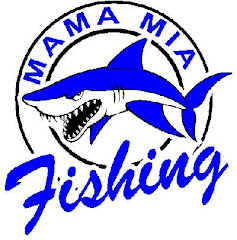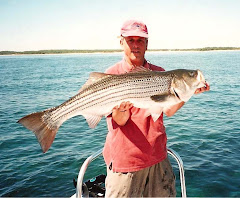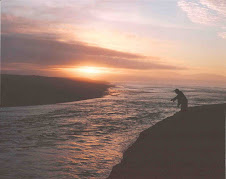I was party to a discussion recently about the optimal size for a saltwater fly. As you might imagine that dialogue was quite lively, with individual preferences all over the lot. One of the anglers suggested a pattern of about two-and-a-half inches in length was his favorite go-to size since that dimension represented most of the bait he encountered. Another angler offered six-inches as his preference, since he tended to fish most frequently during those times of season when big baits were present. And yet anther opined that flies of at least seven-and-a-half inches are ideal if one wanted to really grab the attention of striped bass and feed them a fly of substance.
When it was my turn to speak, the response was measured and a bit hedged. I fly-fish throughout all of the Long Island seasons and in so doing come upon the entire progression of bait available around Long Island, from small shrimp and crabs in the early season to larger shad, bunker and herring as the season advances. Throw in some micro rain bait that we see in the late summer and fall and the entire spectrum of bait sizes are represented. There are certainly times when one must replicate bait as closely as possible in all aspects of conformity if consistent success is to be achieved – but that is not always the case. My arsenal of flies includes pattern sizes from about an inch-and-a-half up to about eight inches. But as you have read here many times before, the most important elements of a fly’s design embrace the characteristics not only of size but of profile, silhouette and contrast as well. That said, I do have one fly wallet just chock full of one fly size that I guess would qualify as a favorite; “…that size is 4-½ inches”. My response generated a question from one of my friends, “Why 4-½ inches and not 4 or 5 inches?” I smiled since that was a very logical question considering I am not an advocate of exact anatomical precision when tying flies.
My answer was simply, “That is the size of one of the most effective swimming plugs of all times.” I was referring to the class of swimming plugs most often associated with the Rebel 4-½ straight and jointed plugs and a similar Rapala and Red Fin series of plugs. The response brought a few quizzical looks from my companions and one asked, “What does that have anything to do with a fly?” I immediately realized that he must have never fished one of those Rebel plugs, for had he done so he would have never asked that question. I’ve lost track of the number of game fish species I’ve caught on that genre of swimming plug and I know of countless anglers from Texas to Maine who have had similar experiences with that “old school” plug and others like it. The successes are endless: largemouth bass, smallmouth, stripers, redfish, snook, trout, bonito, false albacore, Spanish mackerel, pickerel, pike…the list goes on and on. Over time, 4½-inch plugs have consistently gotten the job done. And over time a 4½-inch flies have performed equally as well.
What’s so special about those specific Rebels, Rapalas or Redfins, and what
do they have to do with fly design? First off, I believe the size and action of
those plugs have proven over time to be effective at motivating fish to
strike. Game fish being opportunistic want a substantial meal that appears in
peril, and they prefer not to expend too much caloric energy chasing
down dinner. These swimming plugs can be fished “lazy”, with subtle and
enticing action. The combination of size and action work in concert to present
what appear as easy pickings. To be sure, there are plenty of other smaller
and larger plugs that are as effective as the “4-1/2 inchers ” when employed
under the right sets of circumstances. But in my case and with others I know
who’ve enjoyed these plugs, a heightened degree of confidence is always
evident when one is tied on to the end of a leader.
The fly angler can achieve the many of the same plug results with the right pattern. I’ve known tiers who toiled endlessly attempting to create an exact fly replica of these swimming plugs - a few have come very close to doing so. Many of those flies perform well, and in all cases those that do have success are close size matches to the plugs. Replicating the unique action of a Rebel or a similar-style plug is a horse of a different color. That too takes some doing but successful replica flies have incorporated a variety of natural and synthetic materials and more than just a modicum of ingenuity. One particular fly design incorporates the use of a molded plastic swim lip secured to the head region of the pattern. This innovation gives the fly surprisingly enticing action…not quite the tight motion of the plugs…but close enough to be a stimulant to the fish.
There are no absolutes in fly-fishing - or any fishing for that matter. The only constant in the fishing equation is that fish drive our response to their behavior much more than we motivate their reaction to our flies, lures and plugs. When it comes to the size of a fly, experiment with different patterns under different conditions and always let the fish tell you their preference. And make it a point to keep some 4-½ flies at the ready.
A weekly blog dedicated to fly-fishing the waters of Long Island and other world-class destinations.
About Me
- AP
- Following a long and fulfilling corporate career I moved on to pursue other interests as a full time outdoor journalist, book author, photographer and lecturer. I am also a strategic managment consultant involved in the outdoors, recreation and lesiure time industries. Fly fishing is my favorite pastime but I enjoy all forms of fishing and traditional outdoor activities. When I am not writing you will most often find me exploring my home waters of the Long Island Sound. I am equally as comfortable on a tidal creek in the wilderness of the Alaska Peninsula, or on a Gulf Coast flat or in the waters of a free flowing river. I love to wade, fish from a boat and kayak. If I couldn't fish, my life would not be complete. And should the day ever come when I no longer enjoy catching diminutive bluegill, I will part with all my gear and take up a new sport. Professional Affiliations: Outdoor Writers Association of America; New York State Outdoor Writers Association; Professional Outdoor Media Association; Association of Great Lakes Outdoor Writers. For further information please refer to my website at www.angelopeluso.com
Welcome and Enjoy
Welcome to AP's Fly Fishing Journal, a weekly blog dedicated to the pursuit of fly-fishing. Our focus will be the waters of Long Island and other world-class destinations. Whether you are a novice, intermediate or advanced fly angler, this space will be devoted to topics of interest and value to all who pursue game fish with the long wand. Topics covered will include fly-fishing commentary, fly tying, products and any and all issues relevant to today’s avid fly angler. If you are inclined to cast flies to fish , let this "journal" be your weekly guide to a rewarding time on the water. I will cover saltwater and freshwater, the beach and boating beats as well as the increasingly popular kayak fly-fishing scene. And we will look east and west, north and south - wherever fly anglers roam. I hope you enjoy my offerings. Thank you for stopping by.










